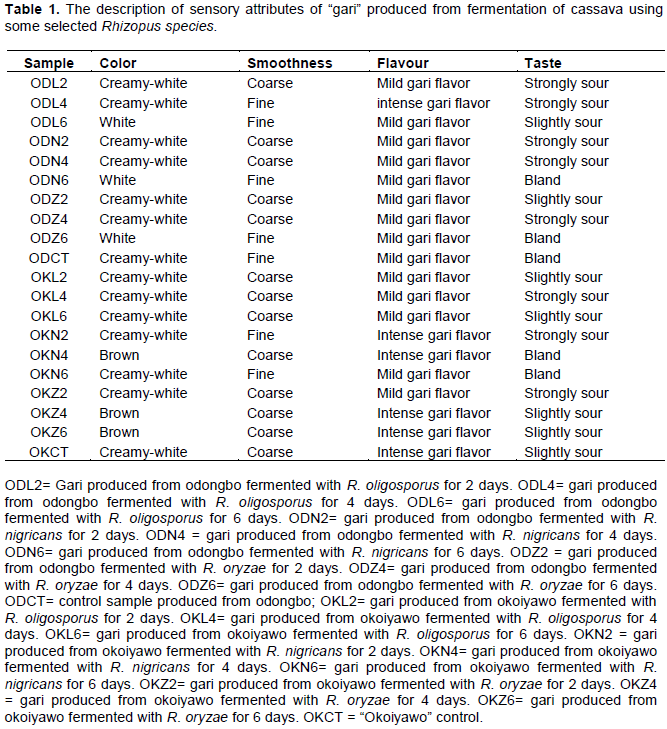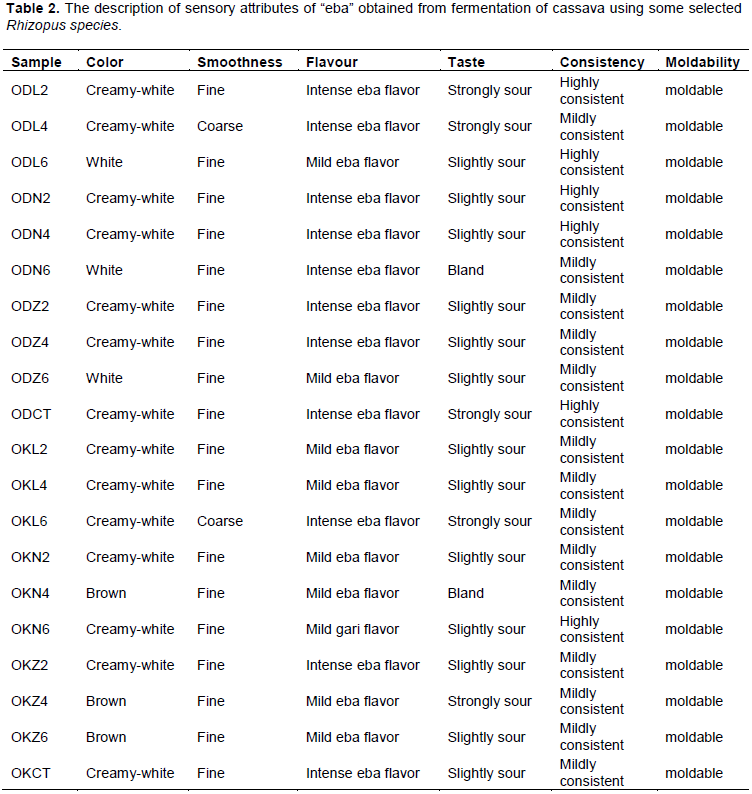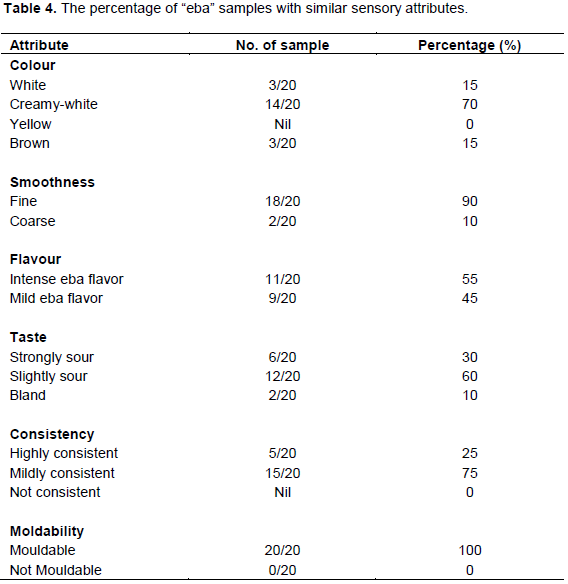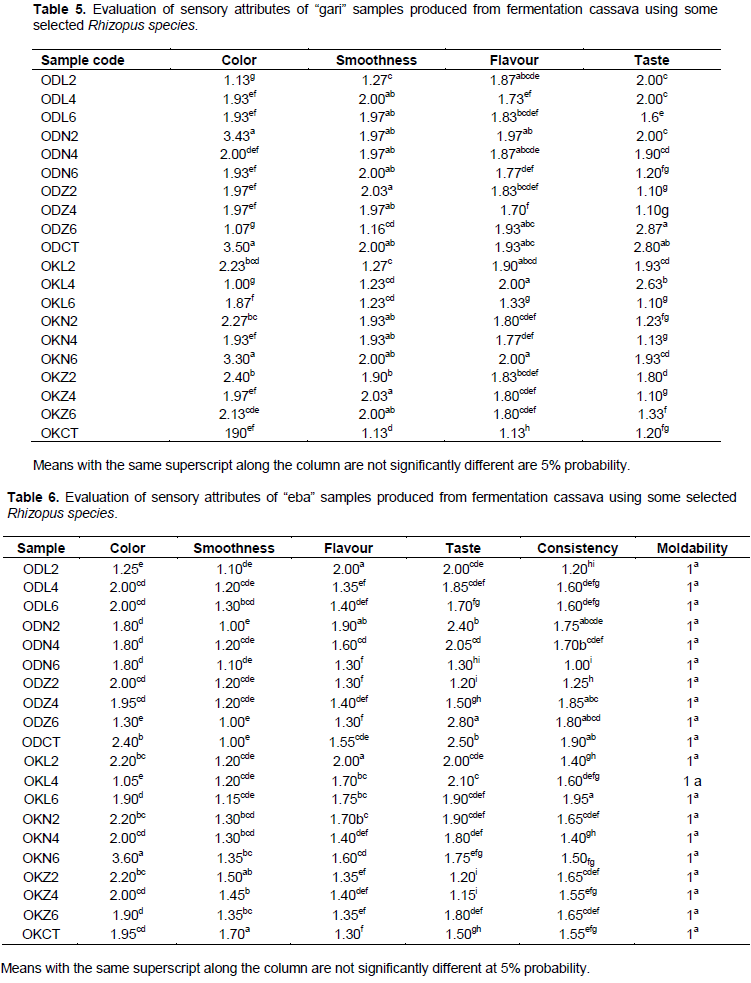ABSTRACT
Two local varieties of cassava (Manihot esculenta crantz) pulps named “okoiyawo” and “odongbo” were fermented with pure Rhizopus oligosporus, R. nigricans and R. oryzae. The products were subsequently processed in to “gari” (a roasted fermented cassava meal), the form in which it is popularly consumed in Nigeria. The selected process variables are cassava varieties, starter culture and fermentation time (2, 4 and 6 days). Fifteen randomly selected and trained panelists in the University carried out descriptive sensory analysis which characterized color, taste, flavor, smoothness, moldability and consistency of “gari” and “eba”. The sensory evaluation of the samples showed that the creamy-white is the most dominant color. A peculiar flavor, fine, and sour “gari”, consistent and moldable “eba” was also obtained. The optimum fermentation time for sensory quality is 48 h (2 days). The samples produced from “odongbo” are of good quality than the ones produced from “okoiyawo”. The selected Rhizopus species had a significant effect on the taste, flavor, and moldability of “eba”. There were significant differences (p<0.05) in the consistencies of the “eba” samples. The highly consistent ones are “odongbo” products while the ones made from “okoiyawo” are mildly consistent. There were no significant differences (p<0.05) in the moldability of “eba” samples.
Key words: Gari, Sensory evaluation, Rhizopus species.
Cassava (Manihot esculenta Crantz) belongs to the family Euphorbiaceae. It is a major carbohydrate staple crop in Nigeria, engaging over four million farmers in production and providing food for over 100 million persons (FAO, 2016). The consumption of cassava (Manihot esculenta Crantz) have been on the increase and planting of cassava has expanded to areas where cassava was not cultivated many years ago (Ogunnaike et al., 2015). It is one of the most important staple food crops grown in the tropical Africa, and plays a major role in effort to alleviate the African food crisis because of its efficient production of food energy, year-round availability, tolerance to extreme stress conditions, and suitability to present farming and food system in Africa (FAO, 2016)
and can be processed into various forms such as gari, fufu and tapioca. Cassava tuber is known to have low protein but rich in vitamin C (35 mg per 100 g fresh weight), and contain traces of niacin, thiamine, riboflavin and vitamin A (Ehirim, 2018; Sineenart et al., 2018).
Solid state fermentation has been used to detoxify cyanide content of cassava and improving its protein values. The most commonly used microorganisms in Solid State fermentation (SSF) are filamentous fungi (Adejuyitan et al., 2019). Filamentous fungi are the most important group of microorganisms used in SSF processes due to their physiological, enzymatic and biochemical properties. Among the microorganisms most used are those belonging to the genus Rhizopus, which have been used for the production of products such as Tempeh, due to the organoleptic and nutritional characteristics that it provides to the product (Olaoye et al., 2015).
Several non-pathogen micro-fungi such as Rhizopus species were used in enriching cassava product with protein. Londono-Hernandez et al., (2018) reported the effect of Rhizopus oryzae on the chemical composition, physical-structural characteristics and nutritional value of sorghum grains. He found out that physical structure of the sorghum starch granules was modified during the fermentation process due to the action of the enzymes, mainly amylases, produced by the microorganism. The fermentation process improved the nutritional characteristics of the sorghum. Fermentation also improved the sensory properties of cassava products such as “gari”, fufu etc.
Gari (a roasted fermented cassava meal) is the most popular cassava product consumed in West Africa and the most important food product in the diet of millions of Ghanaians and Nigerians (Ehirim, 2018). The process of ’’gari’’ production from cassava includes fermentation which may last between one to five days, depending on the region where it is being produced. The longer the time of fermentation, the more desirable its sensory characteristics and the more appealing to the customer. “Gari” has a slightly sour taste and it could be white or cream depending on the variety of cassava used and the processing method adopted. The objective of this study was to determine the sensory characteristics of “gari” and “eba” produced from fermentation of cassava using R. oligosporus, R. oryzae and R. nigricans at different time (2, 4 and 6 days). And also, to determine the effects of processing variables on sensory attributes of the samples.
Raw material sourcing
Manihot utilissima and Manihot palmata (that is, odongbo and okoiyawo) were obtained from Ladoke Akintola University of Technology (LAUTECH) farm, Ogbomoso, Oyo State. The roots were between 10-12 months old. Pure culture of R. oligosporus, R. oryzea, and R. nigricans were obtained from the microbiology laboratory of Department of food Science and Engineering, Ladoke Akintola University of Technology, Ogbomoso, Nigeria.
Production of “gari”
Freshly harvested cassava roots were peeled, washed and grated. The mash was then sterilized for 30 min according to the method described by Oguntimein et al., (1994) using ultraviolet (u.v) sterilizer. 0.5 mL of aliquot of each culture suspension (Rhizopus oligosporus, R. oryzae, and R. nigricans) in nutrient solution as described by Oboh and Akindahunsi (2003) were used as inocula for every 100 g of sterilized cassava mash. The mash was allowed to ferment for 2, 4 and 8 days. The water content in the mash was removed using a screw press. The resulting cake was finally sieved and fried to “gari”. Control sample were also made for each cassava variety without the use of the microorganisms fermented for 3 days. The samples were stored prior to the analyses.
Sensory analysis
Descriptive method
The sensory evaluations were conducted by 15 trained panelists consisting of students who were experienced with the products and terminology. During orientation sessions, the panelists were provided with a glossary of terms and questionnaire which was developed and used throughout the study. Sensory characteristics of the sample were divided into four main categories that included 13 sensory attributes: Color: white, creamy-white, yellow, brown; smoothness: fine, coarse, small lumps, big lumps; flavor: intense “gari” flavor, mild “gari” flavor; taste: strongly sour, slightly sour and bland. The samples were arranged randomly and presented to the panelists in white paper cups to evaluate the aforementioned sensory attributes and indicate the level that describe their perception. Each sample was duplicated and coded in such a way that the panelists could not be biased by the coding system as a set of three digits of random numbers were assigned to each sample. Water was provided to each panelist for use in rinsing mouth between samples. The “gari” samples were then poured in boiling water (gari/water ratio 1:3), covered for a while and turned to “eba” using local turning stick and assessed for the same attributes stipulated above with these exception: Small lumps, big lumps for smoothness. Consistency: Highly consistent, moderately consistent, not consistent and moldability: moldable, not moldable were also examined in “eba” made from the “gari” sample.
Statistical analysis
Data obtained from the panelists were subjected to analysis of variance (ANOVA) using Statistical Analysis System (SAS) at 5% significant level. The mean values of the samples were separated using alphabetical letters to indicate significant difference between the samples.
The descriptions of sensory quality attributes of “gari” and “eba”.
The descriptions of sensory attributes of “gari” and “eba” produced from fermentation of cassava using some selected Rhizopus species are shown in Tables 1 and 2. Table 3 showed the percentage of each sensory attributes of “gari”. In term of color, creamy-white had the highest percentage (70%), while brown and white colour had the same percentage (15%). The dominant texture is coarse (70%), followed by fine texture (30%). In term of flavor, 85% had mild “gari” flavor and 15% had intense “gari” flavor. Moreover, 45% of the samples were strongly sour when tasted, 40% were slightly sour, 15% tasted bland. Similarly, Table 4 showed the percentage of peculiar sensory attributes of “eba” samples. In term of colour, creamy-white had the highest percentage (70%), followed by white (15%), brown (15%), and yellow had nil (0%). Fine texture had the highest percentage (90%), followed by coarse (10%). In term of flavor, 55% had intense “eba” flavor while mild “eba” flavor had 45%. Moreover, 30% of the “eba” samples are strongly sour, 60% are slightly sour while 10% are bland. 25% of are highly consistent, while 75% are mildly consistent. The moldability of the “eba” samples showed that all are moldable (100%).
Effects of process variables on color
The descriptions of color “gari” as well as “eba” samples are shown in Tables 1 and 2. Creamy-white is the most dominant color, followed by white while the least is brown. The statistical analysis showed that the color of “gari” ranged from 1.00 to 3.50. The control sample produced from “odongbo” had the highest mean value (3.50), the control sample produced from “okoiyawo” (OKCT) had 1.90 while the sample produced from “okoiyawo”, fermented by R. oligosporus for 4 days had the least means value. Similarly, the mean value of “eba” ranged from 1.05 to 3.60. The “eba” sample produced from okoiyawo, fermented by R. nigricans (OKN6) for 6 days had the higher value while the sample obtained from “okoiyawo” femented with R. oligosporus for 4 days (OKL4) had the least. The results showed that there was a significant difference in the color of the “gari” and “eba” samples. This may be due to the effects of processing conditions. According to Rosales-Soto et al., (2016), color changes in carbohydrate foods may be due to the chemical reaction between the amino acids and sugars present in the cassava mash, such as caramelization of carbohydrate, maillard reaction. Statistical results (Tables 4 and 5) showed that there was no significant (p<0.05) in the color of most of the “gari” samples fermented for 4 and 6 days, including the control sample, but there was a significant difference when compared with some of the samples fermented for 2 days. This suggests that “gari” color varied with the duration of fermentation (Brimer, 2015). According to Brimer (2015), browning occurs during garrification due to maillard reaction involving amino acids and sugars present in the cassava mash.
Effects on taste
Results of the percentage sensory attributes (Table 3) showed that the taste of about 45% of “gari” samples are strongly sour, 40% are slightly sour, while the remaining 15% are bland. Similarly, 30% of “eba” samples are strongly sour, 60% are slightly sour, while 10% are bland (Table 4). This may be due to the direct manifestations of various biochemical reactions that occur during fermentation. The fermentation processes were characterized by increased acid production (increase in T.T.A and decrease in pH) for all the cassava varieties. Acid production during cassava fermentation has been attributed to the activities of the microbial flora on the carbohydrates of the cassava root (Ogunnaike et al., 2015). Brimer (2015) reported that the rate of biochemical reactions such as cyanide hydrolysis, reducing sugar, and acid production during fermentation bring about the degree in the sourness of the taste of cassava based foods. The acceptability of “gari” is influenced by its sourness, which is related to the amount of lactic acid or length of fermentation (Karim et al., 2016).
The statistical results showed that the taste of “gari” and “eba” samples ranged from 1.10 to 2.87 and 1.15 to 2.80, respectively (Tables 5 and 6). “Gari” produced from “odongbo” fermented by R. oryzae for 6 days (ODZ6) had the highest value while the least value cut across various samples (OKZ4, OKL6, ODZ4 and ODZ2). Similarly, the sample produced from “odongbo” fermented by R. oryzae for 6 days (ODZ6) also had the highest value out of all the “eba” samples while the sample produced from “okoiyawo” fermented by R. oryzae for 4 days (ODZ4) had the least. The result of the statistical analysis showed that there was no significant difference (p<0.05) in the taste of the most of the samples fermented with the selected Rhizopus species for 4 and 6 days but there was a significant difference when compared with the samples fermented for 2 days and the control samples. It also showed that there was no significant difference in the taste of the samples fermented with R. oligosporus and R. nigricans but there was a significant difference when compared with the samples fermented with R. oryzae and the control samples. There was a significant difference in the taste of gari/ eba samples produced from “odongbo” and their control sample as well as the samples produced from “okoiyawo” and their control sample. This suggests that acid production may be dependent not on the cassava variety but on the microbial flora and the processing conditions (Ehirim, 2018). Olaoye et al., (2015) also reported that the taste of “gari” depends on the degree of fermentation. Long fermentation (generally more than three days) results in an unacceptable sour taste.





Effects on aroma
Tables 5 and 6 showed the statistical results of sensory attributes of “gari” and “eba”. “Gari” aroma ranged from 1.13 to 2.00 while that of “eba” ranged from 1.30 to 2.00. Of all the “gari” samples, the sample produced from “okoiyawo”, fermented by R. oligosporus for 4 days (OKL4) had highest mean value for flavor while the control sample produced from “okoiyawo” (OKCT) had the least. Similarly, the sample produced from “okoiyawo” as well as “odongbo”, fermented by R. oligosporus for 2 days (OKL2 and ODL2) had the highest mean value out of all the “eba” samples while the control sample produced from “okoiyawo” had the least.
The result showed that there was a significant difference (p<0.05) between the flavor of the control sample of “gari” and “eba” produced from “odongbo” and other “odongbo” sample fermented with Rhizopus species. Similarly, there was a significant difference in the aroma of “okoiyawo” control sample and other “okoiyawo” samples fermented with Rhizopus species. This may be as a result of the biochemical reactions that occur in the cassava mash when fermented with Rhizopus species. The significant difference in peculiar aroma of “gari” may be due to the variation in the quantity of aldehydes and esters produced during fermentation. Intense “gari” aroma may suggest that the quantity of the aldehydes and esters is adequate in the fermented cassava mash while mild “gari” aroma may connote that the quantity of aldehydes and esters is less. In addition, garrifying process may produce entirely new flavor other than the natural flavor of foods (Sineenart et al., 2018).
Effects on smoothness
The result of the percentage sensory attributes of “gari” and “eba” are shown in Tables 3 and 4. This showed that 70% of “gari” samples are coarse while 30% are fine. After turning the “gari” samples into “eba”, the result shows that 90% are fine while 10% are coarse. This may be due to the effects of some properties of starches in hot water. When a suspension of starch granules in water is heated, the granules swell due to water uptake and gelatinize, this increase the viscosity of the suspension and finally, a paste is formed which on cooling can form a gel and stiffens (Ehirim, 2018).
Tables 5 and 6 showed the statistical analysis of “gari” and “eba” samples. There was no significant difference in the smoothness of “gari” samples produced from “odongbo” and the control sample but some of the samples produced from “okoiyawo” (OKL4, OKL6 and OKCT) are significantly different when compared with those produced from “odongbo”. There was a significant difference between the control sample and other samples produced from “okoiyawo”. Similarly, there was no significant difference in the smoothness of all the “eba” samples produced from “odongbo” and but there was a significant difference when compared with some of the samples produced from “okoiyawo” (OKCT and OKN2). This suggests that cassava variety play a vital role in determining the fineness of the sample or not. This may be attributed to the moisture content in the cultivars and the biochemical reaction that occur in the cassava mash during processing and fermentation (Brimer, 2015). Molds require lesser moisture content for growth while bacteria flourish well in plentiful moisture content. The smoothness of “gari” can also be affected by the efficiency of grating and the method of garrifying (Ehirim, 2018). According to him, when the grating is efficient, the particle sizes should be small. If the initial garrifying temperature is too high, the product becomes lumpy and forms large agglomerates.
Effects on moldability
The result of the moldability of the “eba” samples obtained from the “gari” samples produced from the fermentation of cassava using some selected Rhizopus species is shown in Table 6. This shows that there was no significant difference (p<0.05) between the samples produced from “odongbo” as well as “okoiyawo”. The result of the percentage of “eba” samples on moldability showed that 100% are moldable. This may be due to effective fermentation and garrification. Garrification process causes starch in “gari” to gelatinize. The method and duration of garrifying as well as the temperature of the boiling water used in turning “gari” to “eba” can affect the moldability (Ehirim, 2018).
Effects on consistency
Table 4 showed that percentage of “eba” that are consistent and not consistent. 25% of the samples were highly consistent while 75% were mildly consistent. The consistency of the samples ranged from 1.00 to 1.95 (Table 6). The control sample (OKCT) produced from “okoiyawo” had 1.55 while that of “odongbo” (ODCT) had 1.90. The sample produced from “okoiyawo” fermented with Rhizopus oligosporus 6 days (OKL6) had the highest mean value for consistency while the sample produced from “odongbo” fermented with R. nigricans for 6 days (ODN6) had the least.
The results of the statistical analysis showed that there was a significant difference (p<0.05) in consistency of the samples produced from “okoiyawo” when compared with that of “odongbo”. There was a significant difference in the consistency of the control sample and other samples produced from “odongbo” as well as “okoiyawo” control sample and the remaining samples produced from “okoiyawo”. In addition, there was a significant difference in consistency when comparing the samples that was fermented with R. oligosporus with ones fermented with R. oryzae and R. nigricans. This suggests that the variation in consistency may be due to the effect of cassava varieties, fermentation process and garrifying process. According to Oluwafemi and Udeh (2016), when starch granules is heated, some of the intermolecular hydrogen bonds are disrupted and swelling is noticeable. Further heating causes more loosening of the network, allowing additional water to enter and enlarge the granules.
The study showed that the sensory properties of “gari” and “eba” could be influenced by the process variables used. Rhizopus species effectively ferment cassava mash within two days and produce sour “gari”. The method and duration of garrifying further influence the smoothness of “gari”. Moderate garrifying temperature with consistent stirring of the cake gives fine “gari” but when the initial garrifying temperature is too high, the product become lumpy and forms agglomerates. It is, therefore, concluded that two days fermentation of cassava from “odongbo” are of good quality in term of color, taste, flavor, and smoothness compared with samples produced from “okoiyawo”. The sensory evaluation of the samples showed that the creamy-white is the most dominant color. A peculiar flavor, fine, and sour “gari”, consistent and moldable “eba” was also obtained.
Further research should be carried out on preference test of sensory evaluation to determine consumers’ acceptability of “gari” and “eba” produced from fermentation of cassava using some Rhizopus species.
The authors have not declared any conflict of interests.
REFERENCES
|
Adejuyitan JA, Olanipekun BF, Otunola EA, Osunbade OA (2019). A Novelty of food Fermentation using Non- Pathogenic micro-fungi for Healthy and Nutritious Foods: A Review In: A road map to foods security and Sustainability. Book of Extended Abstracts of the 5th annual conference, regional Food Science and Technology summit, Ilorin, Nigeria. 10th-12th June. 2019.
|
|
|
|
Brimer L (2015). Cassava Production and Processing and Impact on Biological Compounds. In: Processing and Impact on Active Components in Food, Preedy, V. (Ed.). Elsevier Inc., New York, ISBN: 978-0-12-404699-3: 81-87.
Crossref
|
|
|
|
|
Ehirim CC (2018). Effects of Different Processing conditions on the Quality Characteristics of Gari. Unpublished MSc Dissertation. Department of Food Science and Technology, University of Technology, Owerri, Nigeria: 1-15.
|
|
|
|
|
Food and Agriculture Organization (FAO) (2016). Food outlook: Biennial report on global food markets. Food and Agriculture Organization of the United Nations, Rome, Italy.
|
|
|
|
|
Karim OR, Balogun MA, Akintayo OA, Awoyale W (2016). Physical, chemical, and Sensory properties of cassava (manihot esculenta) - sweet potato (Ipomoea batatas) gari. Ukrainian Journal of Food Science 4(2):276-283.
Crossref
|
|
|
|
|
Londono-Hernandez L, Bolivar G, Ramirez T (2018). Effects of Solid State Fermentation with Rhizopus oryzae on biochemical and structural characteristics of Sorghum (Sorghum bicolor (L) Moench). International Journal of Food and Fermentation Technology 8(1):27-36.
Crossref
|
|
|
|
|
Oboh G, Akindahunsi AA (2003). Biochemical changes in Cassava products (flour and garri) subjected to Saccharomyces cerevisae solid media fermentation. Food Chemistry 82(4):599-602.
Crossref
|
|
|
|
|
Ogunnaike AM, Adepoju PA, Longe AO, Elemo GN, Oke OV (2015). Effects of Submerged and anaerobic fermentations on cassava flour. African Journal of Biotechnology 14(1):961-970.
|
|
|
|
|
Oguntimein GB, Akingbala JO, Bolade MK, Abass AB (1994). The effect of processing parameters on gari quality. Biotechnology Network conference 24-26 August, 1994; Bogo, Indonesia.
|
|
|
|
|
Oluwafemi GI, Udeh CC (2016). Effect of fermentation periods on the physicochemical and sensory properties of gari. Journal of Environmental Science 10(1):37-42.
|
|
|
|
|
Olaoye OA, Lawrence IG, Cornelius GN, Ihenetu ME (2015). "Evaluation of quality attributes of cassava product (gari) produced at varying length of fermentation". American Journal of Agricultural Science 2(1):1-7.
|
|
|
|
|
Rosales-Soto MU, Gray PM, Fellman JK, Mattinson DS, Unlu G, Huber K, Powers JR (2016). Microbiological and physico-chemical analysis of fermented protein-fortified cassava (Manihot esculenta Crantz) flour. LWT - Food Science and Technology 66:355-360.
Crossref
|
|
|
|
|
Sineenart P, Metha W, Onanong P, Anusom C, Pongsatorn G, Nirawan G, Sungchhang K (2018). Effects of fermentation using Different Microorganisms on Nutritive Values of Fresh and Dry Cassava Root. Asian Journal of Animal and Veterinary Advances 13(2):128-135.
Crossref
|
|